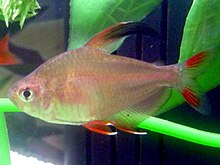Rosy tetra
| Rosy tetra | |
|---|---|

| |
| Male, black fin variant | |
| Scientific classification | |
| Domain: | Eukaryota |
| Kingdom: | Animalia |
| Phylum: | Chordata |
| Class: | Actinopterygii |
| Order: | Characiformes |
| Family: | Characidae |
| Genus: | Hyphessobrycon |
| Species: | H. rosaceus
|
| Binomial name | |
| Hyphessobrycon rosaceus Durbin, 1909
| |
The rosy tetra (Hyphessobrycon rosaceus) is a small species of characin from the South American countries of Guyana and Suriname.[1] It is popular in the aquarium trade.
Description[edit]
The rosy tetra has a light pink-white body with red fins, except the dorsal fin which can be black or white, and the caudal fin which is pink-white with two elliptical red spots on it. It has a faint black line from the top of its eyeball through the pupil, to the bottom of the eyeball. Like many other tetras, the males have longer dorsal fins than the females.[citation needed]
Distribution[edit]
In the wild, the rosy tetra lives in the Essequibo, Corantijn and Suriname River basins in South America.[2]
Reproduction[edit]
The rosy tetra is an egg scattering school spawning fish in the wild. 100 eggs can be laid by one female, usually in the early morning, and over fine leaved plants.[citation needed]
References[edit]
- ^ a b Lima, F. (2023). "Hyphessobrycon rosaceus". IUCN Red List of Threatened Species. 2023: e.T49830051A162751335. doi:10.2305/IUCN.UK.2023-1.RLTS.T49830051A162751335.en. Retrieved 28 December 2023.
- ^ Froese, Rainer; Pauly, Daniel (eds.) (2016). "Hyphessobrycon rosaceus" in FishBase. September 2016 version.

